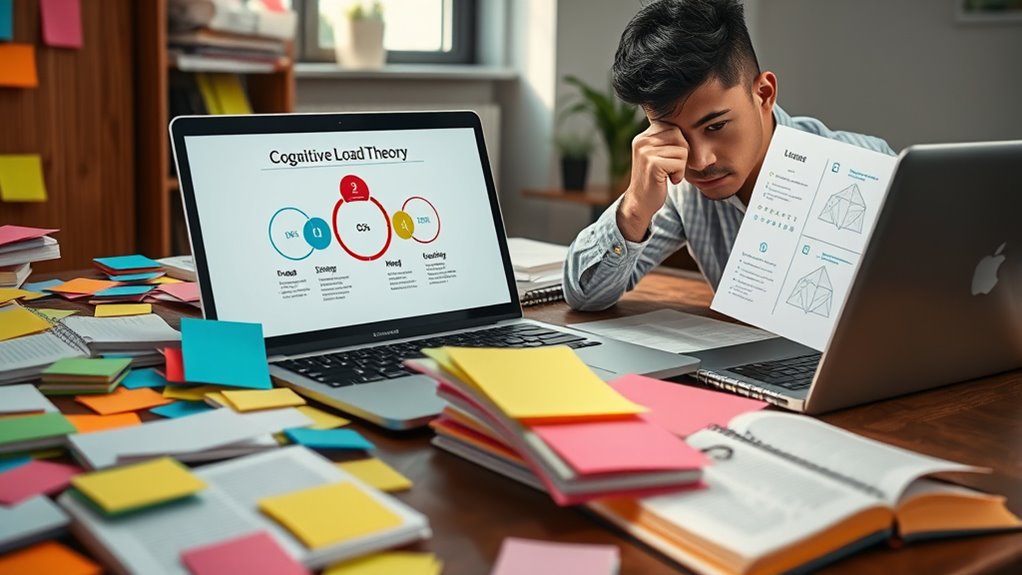Cognitive Load Theory explains how your brain’s limited working memory affects learning. When you face complex ideas or too much information at once, your mental effort increases, making it harder to understand and connect ideas. To lower your cognitive load, break tasks into smaller parts, eliminate unnecessary information, use clear visuals, and connect new ideas to what you already know. Keep exploring to discover simple ways to make learning easier and more effective.
Key Takeaways
- Cognitive Load Theory explains how our brain’s limited working memory affects learning and understanding new information.
- Overloading your brain with complex or extraneous info hampers comprehension and retention.
- To lower cognitive load, break tasks into small steps and remove unnecessary details.
- Connecting new info to what you already know makes learning easier and reduces mental effort.
- Practice and automating skills free mental resources for more complex thinking and better learning.

Cognitive Load Theory explains how the human brain processes and learns information by focusing on the limitations of working memory. Your working memory can only hold a small amount of information at once, which means that when you’re trying to learn something new, your mental effort increases considerably. If you overload your working memory with too much information or complex tasks, your ability to process, understand, and retain that information diminishes. This is where cognitive load becomes a critical factor in effective learning and problem-solving.
Working memory’s limits impact how effectively we process and retain new information.
When you’re faced with complex material, your brain has to work harder to process each piece, which demands more mental effort. This increased effort can lead to cognitive overload, making it harder to absorb new concepts or connect ideas. To improve learning, you need to manage this mental effort by reducing unnecessary load and streamlining information processing. This involves breaking down tasks into smaller, manageable parts, so your brain isn’t overwhelmed by trying to handle everything at once.
One way to lower your cognitive load is by eliminating extraneous information—details that don’t directly contribute to understanding the core concept. When you focus only on essential information, your brain can allocate more resources to processing what truly matters. Using clear, straightforward language and visual aids can also help reduce unnecessary mental effort, making it easier for your brain to make sense of new information. For example, diagrams or charts can simplify complex ideas, allowing your brain to process information more efficiently.
Another strategy is to build upon prior knowledge, which can ease information processing. When new information connects to what you already know, your brain doesn’t have to work as hard to understand it. Instead, it can integrate new concepts smoothly, reducing cognitive load. Additionally, practice and repetition help automate certain tasks, freeing up mental resources for more complex thinking. Over time, this automation decreases mental effort when dealing with familiar problems, allowing you to focus on higher-level understanding.
Understanding how cognitive load affects your mental effort can help you learn more effectively. By consciously managing the amount of information you take in at once and simplifying your approach, you make it easier for your brain to process and remember new material. Recognizing that visual aids and organization can significantly reduce mental effort allows you to tailor your study strategies for better results. This not only improves your learning efficiency but also reduces frustration and mental fatigue, making studying or problem-solving a more manageable and rewarding experience.
Frequently Asked Questions
How Can I Identify if My Cognitive Load Is Too High?
You might notice your working memory feels overwhelmed or you’re struggling to focus, which signals your cognitive load could be too high. If you experience mental fatigue, difficulty processing new information, or frequent mistakes, it’s a sign you’re overloading your mental resources. Pay attention to these signs; they help you identify when your cognitive load is excessive, so you can take steps to relax or simplify tasks to improve your mental clarity.
Are There Specific Tools to Measure Cognitive Load?
Think of your brain like a gym, where mental workload is the weight you’re lifting. To measure this, some tools like NASA-TLX or subjective rating scales act as fitness trackers for your mental load. These tools help you assess how hard your brain is working, much like tracking reps or heart rate during brain training. Using them, you can better understand when your cognitive load becomes too heavy, preventing burnout.
Does Reducing Cognitive Load Improve Learning Speed?
Reducing cognitive load can definitely boost your learning speed by improving memory retention and skill acquisition. When you lower unnecessary mental strain, your brain focuses better on the core material, making it easier to remember and apply. This means you learn faster and retain more. So, simplifying information and eliminating distractions help your brain process new skills more efficiently, leading to quicker mastery and longer-lasting knowledge.
Can Cognitive Load Theory Be Applied to Workplace Training?
Yes, you can apply Cognitive Load Theory to workplace training. It helps you design content that minimizes multitasking challenges and technology distractions, making learning more effective. By simplifying information, breaking tasks into smaller steps, and reducing unnecessary details, you lower mental effort. This keeps employees focused, improves retention, and speeds up skill acquisition, ensuring training is engaging and productive despite the common hurdles of multitasking and constant digital interruptions.
What Are Common Mistakes When Trying to Lower Cognitive Load?
You might unknowingly make mistakes when trying to lower cognitive load, like including extraneous information that distracts learners or encouraging multitasking pitfalls that overwhelm them. These missteps can hinder understanding and retention. Instead, focus on simplifying content and guiding attention. Avoid overloading with unnecessary details and promote focused, single-task engagement. This way, you create a smoother learning experience, helping your audience absorb information more effectively and feel more confident.
Conclusion
Now that you understand cognitive load theory, you’re better equipped to manage your mental space. Remember, piling on too much at once can be a recipe for disaster, so break tasks into manageable chunks and focus on one thing at a time. By doing so, you’ll lighten your mental load and boost your learning efficiency. Keep it simple, stay organized, and don’t let your brain get overwhelmed—you’ll find it pays off in the long run.







